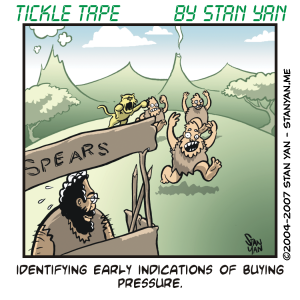In a strong bull market, like one of the late 1990s, you could buy a stock, wait a few weeks, and sell for a profit. During a strong bull market, trading can be relatively easy. You can erroneously think you are a super trader with little experience or talent. Indeed, many seasoned traders tend to admit that they were glad they learned to trade under such ideal conditions.
They concede, “I may have thought I knew how to trade, but I really didn’t have a clue. At least I was able to see what it was like to win, and I got hooked on trading.” The markets eventually turn, and those traders who were riding the wave of a bull market soon learn their strategy was naïve and simplistic. It may work great when the masses, including rank amateurs, will buy almost anything the media touts, but a simple buy-and-hold strategy doesn’t usually work very well when trading short-term choppy markets.
With a few exceptions (such as AAPL in the past 12 months), you cannot usually pick a popular stock, wait for new investors to take advantage of a seemingly linear increase with essentially no resistance, and sell when the profit objective is reached. Ultimately, you must learn to trade under a variety of market conditions, and that means thinking creatively and going your own way. It is just you, the markets, and no one else. So it is vital that you gain as much experience as possible, and learn to trust your intuition.
Trusting your intuition is the hard part. It requires you to look inward to decide what to do. You can’t depend on mass opinion. They are usually right in a strong bull market, but dead wrong when the markets change. Following the crowd may work sometimes, but it’s not a strategy that works consistently. You can’t assume that when you “buy low,” there will be a large cache of naïve amateur buyers ready to keep pushing the price up higher. If you wait too long, you’ll likely hit resistance, and it will be too late to profit from the move. It is nice when this strategy works, though. It is psychologically pleasing. You can buy, see other people buy, hear analysts rave about the stock, and feel a sense of security in that all agree that the mood is bullish and all you have to do is wait it out. Even when the trend is moving in your favour, it isn’t always easy to capitalize on it, however.
What happens when you have to sell to make a profit? The precise time you sell dictates the profits you can take. If you sell right as the market starts to turn, you may not be able to close out your position. Everyone will be selling as if the herd is running for cover. If you aren’t careful, you will get trampled. Well, metaphorically speaking. It is vital that you gauge the phase that the market is in, anticipate what will happen next, and enter and exit a trade at optimal times. Ideally, you have to sell when there are available buyers before the trend reverses. It is hard to know when to do that. In the end, you must rely on your experience and intuition.
For example, as we’ve mentioned in previous columns, AAPL has been steadily increasing for the past 12 months. One day last week, AAPL closed at over $80 a share. If you bought a few months ago at $60 and sold recently, you would have made quite a profit. You’ve probably heard, as we have, about some amateur online investors who cashed out their position and bought a new car or took a cruise. When a stock goes up so steadily, it doesn’t take much skill to make a profit. But as active traders, we can’t count on such a straightforward trend. At this moment, for example, some traders wonder when AAPL will reverse.
Will consumers stop buying iPods soon? Will new products sell poorly? Will delivery deadlines be missed? Perhaps some specialists know, but many do not. In the end, you have to rely on your own intuition, and accept the consequences. If you bought at $60 and sold at $70, you can’t berate yourself for not waiting until AAPL hit $80. You have to go your own way and use your intuition. For all you knew, if you didn’t sell at $70, and the tech sector went dramatically awry, AAPL may have decreased to the point where you couldn’t sell for a profit. As an independent thinker, you have to go your own way and live with the consequences.
Trading is hard. That’s why few realize big profits. To become a master trader you must gain a wealth of experience with the markets and learn to trust your intuition. If you can go your own way at the right time, you’ll make huge profits and become a winning trader.


